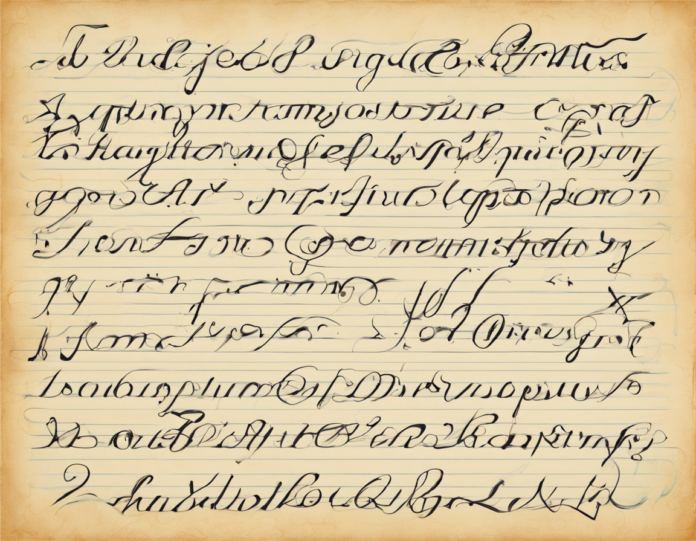Mastering cursive writing is a valuable skill that can enhance your communication abilities, boost your cognitive skills, and leave a lasting impression on those who receive handwritten notes from you. In today's digital age, where typing has become the predominant form of communication, the art of cursive writing is often overlooked. However, cursive writing offers unique benefits that are worth exploring and incorporating into your daily routine.
The Importance of Cursive Writing
Cursive writing is more than just a stylistic choice; it offers numerous benefits that can positively impact various aspects of your life. Here are some reasons why mastering cursive writing is worth your time and effort:
- Enhanced Brain Development: Research suggests that cursive writing stimulates neural pathways in the brain that are not activated by typing on a keyboard. This can lead to improved cognitive development, better memory retention, and enhanced critical thinking skills.
- Improved Hand-Eye Coordination: Writing in cursive requires precise hand movements and coordination between the eyes and hands. Practicing cursive regularly can help improve your fine motor skills and hand-eye coordination.
- Personal Touch: Handwritten notes in cursive are often perceived as more personal, thoughtful, and sincere than typed messages. In a world inundated with digital communication, a handwritten cursive letter can make a lasting impression.
- Historical Significance: Cursive writing has a rich history and cultural significance. By mastering cursive, you are preserving a traditional form of communication that has been passed down through generations.
- Signature Style: Your cursive handwriting is a unique reflection of your personality and style. Developing your own signature cursive style can set you apart and make your written communication stand out.
Getting Started with Cursive Writing
If you're new to cursive writing or looking to improve your existing skills, here are some tips to help you get started:
1. Learn the Basic Strokes: Start by practicing basic cursive strokes, such as loops, curves, and connections between letters. Mastering these fundamental movements will form the foundation of your cursive handwriting.
2. Use the Right Tools: Invest in a good quality fountain pen or a pen with a fine tip to practice cursive writing. The right tools can make a significant difference in the quality of your handwriting.
3. Practice Regularly: Like any skill, cursive writing requires consistent practice to improve. Set aside time each day to practice your cursive letters and words. Gradually increase the complexity of words as you become more proficient.
4. Focus on Consistency: Pay attention to the consistency of your letter formations, spacing between words, and overall legibility. Consistency is key to developing a polished cursive style.
5. Seek Feedback: Ask for feedback from friends, family, or peers on your cursive writing. Constructive feedback can help you identify areas for improvement and refine your skills.
Advanced Techniques for Mastering Cursive Writing
Once you have mastered the basics of cursive writing, you can explore advanced techniques to enhance your skills further. Here are some tips for taking your cursive handwriting to the next level:
- Experiment with Different Styles: Explore various cursive styles, such as italic cursive, copperplate script, or modern calligraphy. Find a style that resonates with you and practice emulating it in your writing.
- Practice Letter Connections: Work on connecting cursive letters smoothly and elegantly. Pay attention to the flow of your writing and aim for seamless transitions between letters.
- Focus on Flourishes: Add decorative flourishes and embellishments to your cursive writing to give it a more elegant and artistic look. Experiment with flourishes at the beginning and end of words or within the body of letters.
- Study Calligraphy: Delve into the art of calligraphy to learn advanced penmanship techniques, such as letter shading, line variation, and ornamental penmanship. Incorporating calligraphic elements into your cursive writing can elevate its aesthetic appeal.
- Create Practice Sheets: Design custom practice sheets with words, phrases, or quotes that you find inspiring. Practice writing these texts in cursive to improve your fluency and confidence.
FAQs about Cursive Writing
- Is cursive writing still relevant in the digital age?
-
While digital communication is prevalent, cursive writing remains relevant for its personal touch, cognitive benefits, and historical significance.
-
Can adults learn cursive writing?
-
Yes, adults can learn cursive writing through practice, patience, and dedication. It's never too late to develop this skill.
-
How long does it take to master cursive writing?
-
The time it takes to master cursive writing varies depending on individual proficiency and practice frequency. Consistent practice can lead to significant improvement over a few weeks to months.
-
Is cursive writing mandatory in schools?
-
Cursive writing is no longer a mandatory part of school curricula in many places. However, some educators and parents advocate for its retention due to its cognitive benefits.
-
Can cursive writing improve memory retention?
- Research suggests that the act of writing in cursive can enhance memory retention and stimulate cognitive functions in the brain.
In conclusion, mastering cursive writing is a rewarding endeavor that offers a myriad of benefits beyond just improved penmanship. By dedicating time to practice and refine your cursive skills, you can enhance your cognitive abilities, develop a unique writing style, and add a personal touch to your communications. Whether you're a beginner or looking to elevate your existing cursive handwriting, the tips and techniques shared in this comprehensive guide can help you on your journey to becoming a proficient cursive writer.

